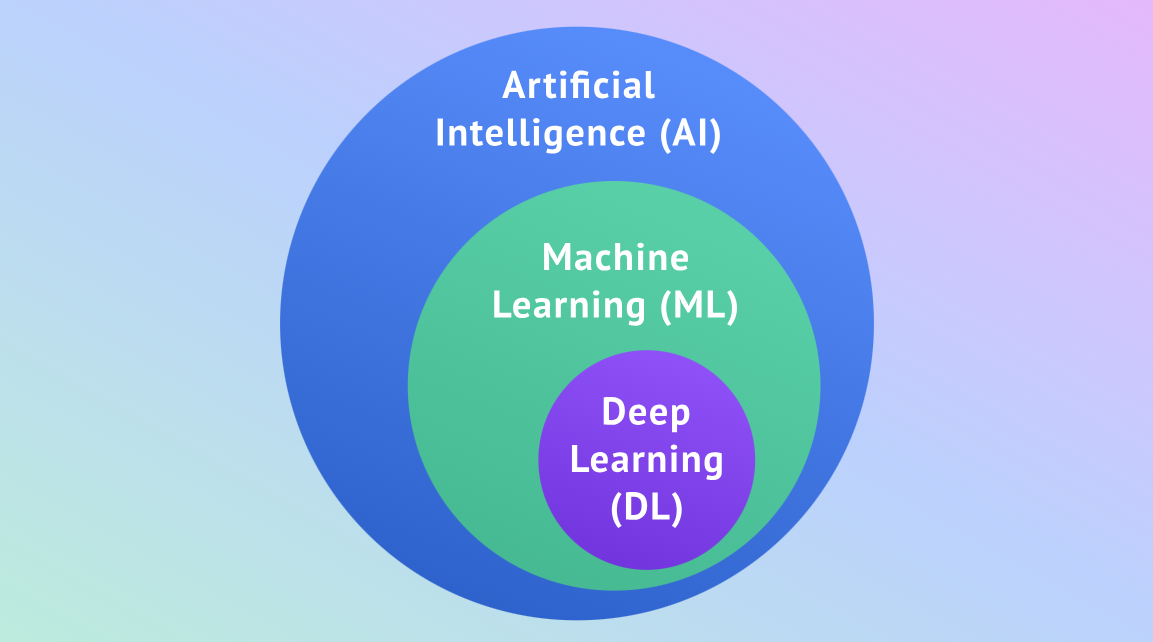Deep Learning, Machine Learning, and AI, Oh My!
A succinct guide to AI terminology
Artificial intelligence (AI), machine learning (ML), and deep learning (DL) are all related, but not synonymous. This blog post will explain the differences between each term with simple descriptions and examples, including the applications of DL: generative and discriminative AI. Understanding these distinctions will help readers extract greater value from AI literature, discussions, and GIQ® blog posts.
Deep learning is a sub-field of machine learning, which is itself a sub-field of artificial intelligence. As the figure suggests, these fields are completely overlapping, and therefore, not distinct from one another. However, their definitions become narrower as we move from AI to DL. By the end of this post, you will be able to classify where common applications of AI like DALL-E, ChatGPT, and autonomous driving sit within the AI hierarchy.

Artificial Intelligence (AI): AI is a branch of computer science that allows computers and machines to perform tasks that typically require human intelligence. AI systems can learn from experience, understand natural language, recognize patterns, solve problems, and make decisions. They can also analyze data and make predictions.
Example: Self-driving cars are an example of AI. Although autonomous vehicles may incorporate some elements of ML, they predominantly use rule-based learning to mimic human behavior. Positive and negative points are assigned to various actions, with positive points being assigned to safe driving behavior and negative points being assigned to dangerous driving. Through trial and error, the machine will optimize its score and learn how to drive. This example falls under AI (as opposed to ML) because the system is programmed with rules instead of learning autonomously from data.
Machine Learning (ML): ML is a field of artificial intelligence where algorithms learn from data to make predictions or decisions without being explicitly programmed. ML can work with structured data (e.g., tabular data, spreadsheets) and can also handle unstructured data (e.g., text, images, audio). However, traditional ML algorithms typically require more engineering than deep learning to transform the data and select important features.
Example: Recommendation systems, such as those used by streaming services, e-commerce websites, and social media platforms, are a common application of ML. They suggest your next TV show, YouTube video, or Amazon product based on your previous decisions and preferences.
Deep Learning (DL): Deep learning is a sub-field of machine learning that uses artificial neural networks (ANNs). These networks can model intricate data patterns and are particularly powerful for tasks like image recognition and natural language processing. The number of hidden layers in the ANN (the depth) dictates whether the network is considered “shallow” or “deep.” Deep neural networks excel in extracting abstract features from large amounts of unstructured data and accept many data inputs (text, audio, video, etc). This is particularly useful in tasks like image and speech recognition. However, they require a lot of time and resources to train, and perform best with large training datasets.
Deep learning can generally be categorized into two main types: discriminative and generative.
Generative AI (GenAI): GenAI is an application of deep learning which generates new data points resembling the training data. This includes text generation, image generation, style transfer, and data synthesis. Examples include large language models (LLMs) like ChatGPT and image generators like DALL-E.
Discriminative AI: Discriminative AI is the other application of deep learning which focuses on predicting the correct label or output given an input. This is how your phone recognizes cats or dogs in your photos. There are numerous applications in medicine, such as AI sorting cancer cells from healthy cells in a sample of human tissue.
GIQ® LLC and AI Innovations
GIQ® LLC invests in companies at every level of the AI/ML/DL hierarchy. Foundational and protectible innovations can occur anywhere in this hierarchy, from rule-based learning and decision-making to machine learning techniques, deep learning neural networks, and GenAI applications. Please contact us if you believe your AI technology may qualify as a foundational innovation in any one of these areas.
[1] https://levity.ai/blog/difference-machine-learning-deep-learning
[2] https://www.ibm.com/topics/machine-learning
[3] WIPO Patent Landscape Report https://www.wipo.int/web-publications/patent-landscape-report-generative-artificial-intelligence-genai/en/index.html
[4] Image from: https://datasaur.ai/blog-posts/differences-between-ai-ml-and-dl


